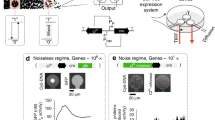Abstract
Because of the simplicity of cells, the key to building biological computing systems may lie in constructing distributed systems based on cell–cell communication. Guided by a mathematical model, in this study we designed, simulated, and constructed a genetic double-branch structure in the bacterium Escherichia coli. This genetic double-branch structure is composed of a control cell and two reporter cells. The control cell can activate different reporter cells according to the input. Two quorum-sensing signal molecules, 3OC12-HSL and C4-HSL, form the wires between the control cell and the reporter cells. This study is a step toward scalable biological computation, and it may have many potential applications in biocomputing, biosensing, and biotherapy.





Similar content being viewed by others
References
Nurse P (2008) Life, logic and information. Nature 454:424–426
Benenson Y (2012) Biomolecular computing systems: principles, progress and potential. Nat Rev Genet 13:455–468
Sipper M (1999) The emergence of cellular computing. Computer 32:18–26
Purnick PEM, Weiss R (2009) The second wave of synthetic biology: from modules to systems. Nat Rev Mol Cell Biol 10:410–422
Macia J, Posas F, Solé RV (2012) Distributed computation: the new wave of synthetic biology devices. Trends Biotechnol 30:342–349
Nealson KH, Platt T, Hastings JW (1970) Cellular control of synthesis and activity of bacterial luminescent system. J Bacteriol 104:313–322
Miller MB, Bassler BL (2001) Quorum sensing in bacteria. Annu Rev Microbiol 55:165–199
Camilli A, Bassler BL (2006) Bacterial small-molecule signaling pathways. Science 311:1113–1116
Waters CM, Bassler BL (2005) Quorum sensing: cell-to-cell communication in bacteria. Annu Rev Cell Dev Biol 21:319–346
González JE, Marketon MM (2003) Quorum sensing in nitrogen-fixing rhizobia. Microbiol Mol Biol Rev 67:574–592
González JE, Keshavan ND (2006) Messing with bacterial quorum sensing. Microbiol Mol Biol Rev 70:859–875
You LC, Cox RS, Weiss R et al (2004) Programmed population control by cell–cell communication and regulated killing. Nature 428:868–871
Basu S, Gerchman Y, Collins CH et al (2005) A synthetic multicellular system for programmed pattern formation. Nature 434:1130–1134
Tamsir A, Tabor JJ, Voigt CA (2011) Robust multicellular computing using genetically encoded nor gates and chemical ‘wires’. Nature 469:212–215
Gardner TS, Cantor CR, Collins JJ (2000) Construction of a genetic toggle switch in Escherichia Coli. Nature 403:339–342
Kramer BP, Viretta AU, Daoud-El-Baba M et al (2004) An engineered epigenetic transgene switch in mammalian cells. Nat Biotechnol 22:867–870
Tan C, Marguet P, You LC (2009) Emergent bistability by a growth-modulating positive feedback circuit. Nat Chem Biol 5:842–848
Ham TS, Lee SK, Keasling JD et al (2008) Design and construction of a double inversion recombination switch for heritable sequential genetic memory. PLoS One 3:e2815
Ham TS, Lee SK, Keasling JD et al (2006) A tightly regulated inducible expression system utilizing the fim inversion recombination switch. Biotechnol Bioeng 94:1–4
Deans TL, Cantor CR, Collins JJ (2007) A tunable genetic switch based on RNAi and repressor proteins for regulating gene expression in mammalian cells. Cell 130:363–372
Halter M, Tona A, Bhadriraju K et al (2007) Automated live cell imaging of green fluorescent protein degradation in individual fibroblasts. Cytometry A 71A:827–834
Stricker J, Cookson S, Bennett MR et al (2008) A fast, robust and tunable synthetic gene oscillator. Nature 456:516–519
Siuti P, Yazbek J, Lu TK (2013) Synthetic circuits integrating logic and memory in living cells. Nat Biotechnol 31:448–452
Sleight SC, Bartley BA, Lieviant JA et al (2010) In-Fusion BioBrick assembly and re-engineering. Nucleic Acids Res 38:2624–2636
Acknowledgments
This work was supported by the National Basic Research Program of China (2013CB329601 and 2013CB329602), and the National Natural Science Foundation of China (61127005, 60974112, 30970960, 60910002, 60971085, and 61100055).
Conflict of interest
The authors declare that they have no conflict of interest.
Author information
Authors and Affiliations
Corresponding author
Electronic supplementary material
Below is the link to the electronic supplementary material.
About this article
Cite this article
Chen, M., Zhang, L. & Xu, J. Distributed implementation of the genetic double-branch structure in Escherichia coli . Chin. Sci. Bull. 59, 4625–4630 (2014). https://doi.org/10.1007/s11434-014-0516-y
Received:
Accepted:
Published:
Issue Date:
DOI: https://doi.org/10.1007/s11434-014-0516-y




